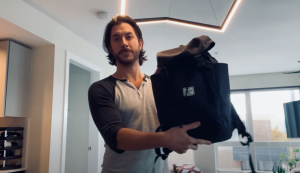Qu’est-ce qu’il y a dans mon sac / What is in my bag ?

I found it challenging to wrap my head around this week’s task: how to change the semiotic mode without simply recording the description of Task One. I then realized that, as a student, what I could benefit from was an example of a task. This is best practice as a teacher since students want to know exactly what they need to do to be successful on a project. I try my best to offer past examples of videos or physical products to present to them in the initial class or week when a project is explained. A challenge, of course, is when it is my first time trying out a new project (perhaps I am using a new textbook– as I recently experienced last year).
I decided to take Task One and repurpose/adapt it to be a French class project. In fact, “Mon sac de vie” is a project that I have done in the past, but I haven’t used in many years. The students bring a personal bag and five important items that represent them or have a story, and present them to the class.
A few things to keep in mind when watching the video:
- I modelled a slower speech rate for students to better understand me and to be able to reproduce words and phrases used. After watching the video, I could have spoken even slower if this were a grade 8 or 9 project.
- I exaggerated my pronunciation. I felt like an actor in the cheesy textbook videos that I use for my French 10 class.
- I modelled connecting words and useful phrases such as “firstly”, “second”, “then”, “of course”.
- None of my sentences were too complex. I wanted to demonstrate sentences that my students can create without cheating with Google Translate (the bane of my existence as a language teacher).
- I completed the task without reading from a script. This is an expectation for higher level students and perhaps younger ones can be allowed to read cue cards, depending on their level. This could also be the difference between a “proficient” and an “extending” mark (we use a Standards Based Grading System with extending-proficient-developing-emerging-limited performance indicators).
Sometimes rubrics simply aren’t enough. Teachers work diligently creating and recreating them. We also spend hours upon hours discussing them in departmental meetings. In addition, I spend too much time re-inventing the wheel and tailoring each rubric to a specific task. Using a common rubric, with task-specific objectives and content requirements, as well as offering student examples is best practise.
One final thought: another possibility would be to offer two pieces of work (removing student names if possible). One would be an “extending” example; the other, a “developing” one. In this case, students can reflect on both, mark them as if they were the teacher and we can, as a class, discuss and come to a consensus on the strengths and weaknesses of both projects.